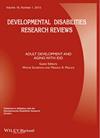Roger E. Stevenson, Charles E. Schwartz
{"title":"X-linked intellectual disability: Unique vulnerability of the male genome†","authors":"Roger E. Stevenson, Charles E. Schwartz","doi":"10.1002/ddrr.81","DOIUrl":null,"url":null,"abstract":"<p>X-linked intellectual disability (XLID) accounts for ∼16% of males with intellectual disability (ID). This is, in part, related to the fact that males have a single X chromosome. Progress in the clinical and molecular characterization of XLID has outpaced progress in the delineation of ID due to genes on the other 22 chromosomes. Almost half of the estimated 200 XLID genes have been identified and another 20% have been regionally mapped. These advances have had immediate benefits for families, allowing for carrier testing, genetic counseling, prenatal diagnosis, and preimplantation genetic diagnosis. Additionally, the combination of clinical delineation with gene identification and the development of gene panels for screening nonsyndromal XLID has been able to limit unproductive laboratory testing. Most importantly for the patients, some of the gene discoveries have pointed to potential strategies for treatment. © 2009 Wiley-Liss, Inc. Dev Disabil Res Rev 2009;15:361–368.</p>","PeriodicalId":55176,"journal":{"name":"Developmental Disabilities Research Reviews","volume":"15 4","pages":"361-368"},"PeriodicalIF":0.0000,"publicationDate":"2009-12-15","publicationTypes":"Journal Article","fieldsOfStudy":null,"isOpenAccess":false,"openAccessPdf":"https://sci-hub-pdf.com/10.1002/ddrr.81","citationCount":"61","resultStr":null,"platform":"Semanticscholar","paperid":null,"PeriodicalName":"Developmental Disabilities Research Reviews","FirstCategoryId":"1085","ListUrlMain":"https://onlinelibrary.wiley.com/doi/10.1002/ddrr.81","RegionNum":0,"RegionCategory":null,"ArticlePicture":[],"TitleCN":null,"AbstractTextCN":null,"PMCID":null,"EPubDate":"","PubModel":"","JCR":"","JCRName":"","Score":null,"Total":0}
引用次数: 61
Abstract
X-linked intellectual disability (XLID) accounts for ∼16% of males with intellectual disability (ID). This is, in part, related to the fact that males have a single X chromosome. Progress in the clinical and molecular characterization of XLID has outpaced progress in the delineation of ID due to genes on the other 22 chromosomes. Almost half of the estimated 200 XLID genes have been identified and another 20% have been regionally mapped. These advances have had immediate benefits for families, allowing for carrier testing, genetic counseling, prenatal diagnosis, and preimplantation genetic diagnosis. Additionally, the combination of clinical delineation with gene identification and the development of gene panels for screening nonsyndromal XLID has been able to limit unproductive laboratory testing. Most importantly for the patients, some of the gene discoveries have pointed to potential strategies for treatment. © 2009 Wiley-Liss, Inc. Dev Disabil Res Rev 2009;15:361–368.
x连锁智力残疾:男性基因组的独特脆弱性†
x连锁智力残疾(XLID)占男性智力残疾(ID)的16%。在某种程度上,这与男性只有一条X染色体有关。由于其他22条染色体上的基因,XLID的临床和分子表征的进展超过了ID的描述。在估计的200个XLID基因中,几乎有一半已经被确定,另外20%已经被区域定位。这些进步为家庭带来了立竿见影的好处,包括携带者检测、遗传咨询、产前诊断和胚胎植入前遗传学诊断。此外,临床描述与基因鉴定的结合以及用于筛选非综合征性XLID的基因面板的发展已经能够限制非生产性实验室测试。对患者来说最重要的是,一些基因发现指出了潜在的治疗策略。©2009 Wiley-Liss, Inc。发展与残疾,2009;15:31 61 - 368。
本文章由计算机程序翻译,如有差异,请以英文原文为准。

 求助内容:
求助内容: 应助结果提醒方式:
应助结果提醒方式:


